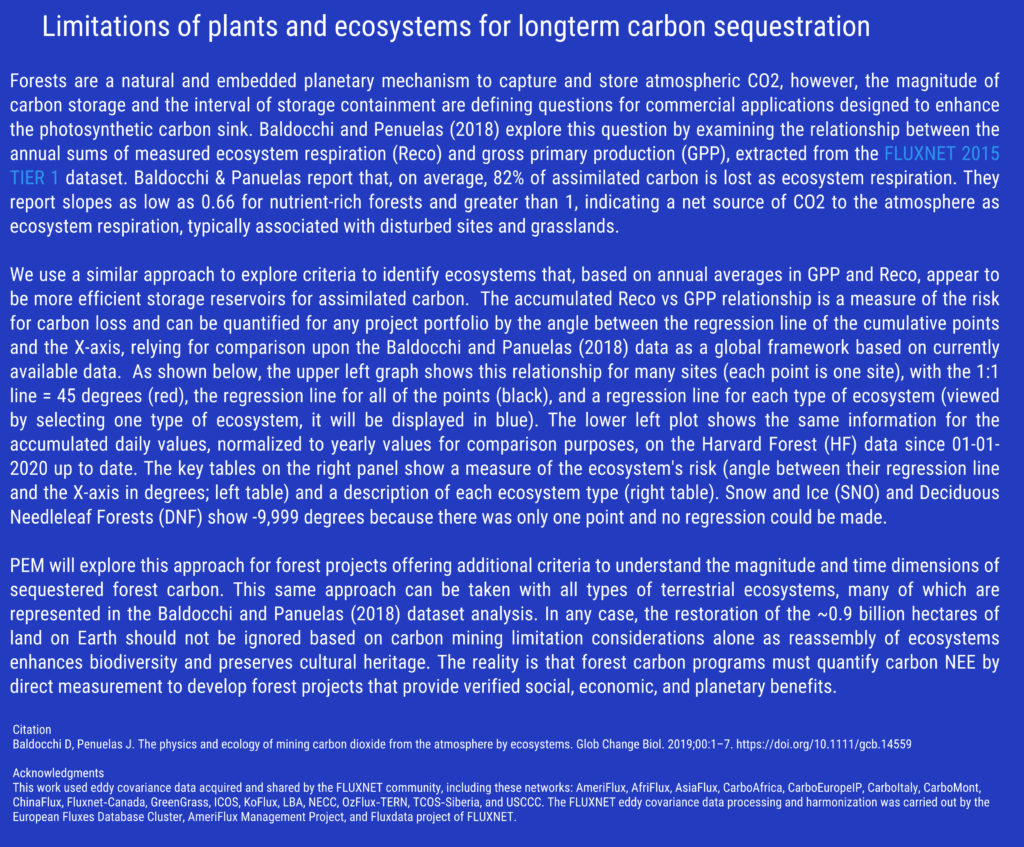THE HARVARD FOREST CARBON FLUX EXPERIMENT
29 YEARS of RESULTS
Bruno D.V. Marino & Nahuel Bautista, Planetary Emissions Management Inc., © 2020 All Rights Reserved
The Harvard Forest Carbon Flux Ticker
Recent daily financial carbon (NEE) per acre
CO2 $152 per tonne
CO2 $51 per tonne

–
The social cost of carbon (2020) at 3% discount rate, and 3% discount rate 95% percentile were $51 and $152, respectively. Details about this estimation can be found in “Technical Support Document: Social Cost of Carbon, Methane, and Nitrous Oxide. Interim Estimates under Executive Order 13990”.
Recent half-hourly fluxes
Half hourly NEE (blue line), Reco (orange line), and GPP (green line) fluxes over the last week in the Harvard Forest Eddy Covariance Tower (US-Ha1; micromole per square meter per second).


Use fullscreen option to enlarge


Use fullscreen option to enlarge

Methods
Every day our system downloads new data from the Harvard Forest tower, labels all the NEE values outside the range (-60; 40) micromol m-2 s-1 as outliers, and discards them. Then, it removes the periods of low turbulence by setting a friction velocity (u*) threshold, according to Papale et al. (2006). The missing data can be up to 50% at this moment, thus it uses a Lookup Table that fills the gaps with the mean NEE measured at similar meteorological conditions in a 14-day time window around the measurement. If it doesn’t find any value, the algorithm will increase the size of the time window and relax the similarity conditions until it finds an appropriate value (Reichstein et al., 2005).
The system calculates Reco using only measured data with the nighttime approach (Reichstein et al., 2005). This method consists of fitting an exponential temperature-dependent model for Reco following Lloyd and Taylor (1994) with only nighttime data. Then, it extrapolates the result to the daytime data and calculates GPP as the difference between NEE (measured or filled) and Reco (estimated).
All the process is done automatically on the Google Cloud Platform in Python 3.7 and the R package “REddyProc” (Wutzler et al., 2018).
References
Lloyd, J., & Taylor, J. (1994). On the Temperature Dependence of Soil Respiration. Functional Ecology, 8(3), 315-323. doi:10.2307/2389824
Papale, D., Reichstein, M., Aubinet, M., Canfora, E., Bernhofer, C., Kutsch, W., Longdoz, B., Rambal, S., Valentini, R., Vesala, T., Yakir, D. (2006). Towards a standardized processing of Net Ecosystem Exchange measured with eddy covariance technique: algorithms and uncertainty estimation. Biogeosciences, 3(4), 571–583. doi:10.5194/bg-3-571-2006
Reichstein, M., Falge, E., Baldocchi, D., Papale, D., Aubinet, M., Berbigier, P., Bernhofer, C., Buchmann, N., Gilmanov, T., Granier, A., Grünwald, T., Havránková, K., Ilvesniemi, H., Janous, D., Knohl, A., Laurila, T., Lohila, A., Loustau, D., Matteucci, G., Meyers, T., Miglietta, F., Ourcival, J.‐M., Pumpanen, J., Rambal, S., Rotenberg, E., Sanz, M., Tenhunen, J., Seufert, G., Vaccari, F., Vesala, T., Yakir, D. and Valentini, R. (2005), On the separation of net ecosystem exchange into assimilation and ecosystem respiration: review and improved algorithm. Global Change Biology, 11: 1424-1439. doi:10.1111/j.1365-2486.2005.001002.x
Wutzler T, Lucas-Moffat A, Migliavacca M, Knauer J, Sickel K, Sigut, Menzer O & Reichstein M (2018) Basic and extensible post-processing of eddy covariance flux data with REddyProc. Biogeosciences, Copernicus, 15. doi: 10.5194/bg-15-5015-2018


